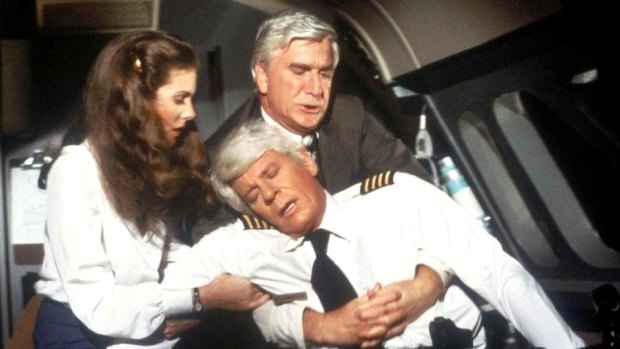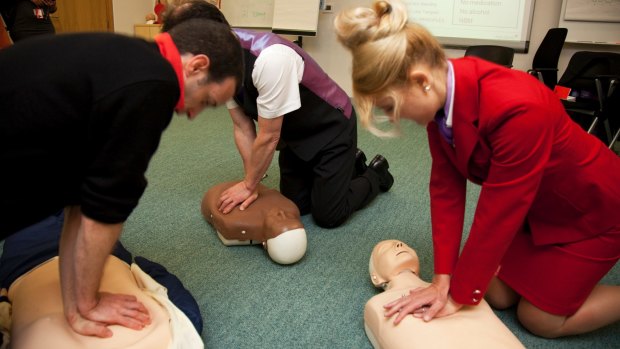This was published 7 years ago
Doctors on board planes: What happens when there's a medical emergency on a flight?
By Michael Gebicki

Passengers were lucky Dr. Rumack (Leslie Nielsen, rear) was on board in 1980 comedy film Flying High.
"If there is a doctor on board could you make yourself known to the cabin staff?"
It's the inflight announcement you never want to hear. If you're the patient, what you're about to read might not soothe your fears because the outcome depends on luck and whatever medical professionals happen to be on board, perhaps more than it should.
Pinning down a figure for the incidence of inflight medical emergencies is complicated since airlines are not required to report such incidents. A 2013 study published in the New England Journal of Medicine suggested a figure of 16 medical emergencies or one for every million passengers. Data from the Lufthansa registry suggests between 25 and 100 per one million passengers while researchers at the University of Pittsburgh Medical Centre came up with a lesser figure, about one per 600 flights, or around 10 for every million passengers.

Virgin Atlantic flight attendants undergo medical training. All airlines are required to provide first aid training for cabin crew.Credit: Getty Images
The same UPMC study, which took a close look at almost 12,000 inflight medical emergencies, reported that in 37 per cent of cases the issue was temporary loss of consciousness due to a fall in blood pressure. Respiratory symptoms accounted for 12 per cent, nausea or vomiting for 10 per cent and cardiac symptoms 8 per cent. In roughly three quarters of those cases flight crews requested and received assistance from passengers with medical training. Almost half the time at least one of the responders was a medical doctor. Out of those almost 12,000 inflight medical emergencies, just 36 resulted in deaths.
While inflight medical emergencies present unique challenges, the UPMC study also concluded that flight crews and the volunteers assisting them generally have the resources they need to deal with most emergencies.
All airlines are required to provide first aid training for cabin crew to enable them to recognise common symptoms of distress and to respond with first-aid, basic resuscitation techniques and the use of emergency medical oxygen and a defibrillator. According to a Qantas spokesperson, the airlines' cabin crew undergo a refresher course each year which also covers first aid.
Since deaths inflight are rare, and space is at a premium, airlines do not have a dedicated area on their aircraft in which to store a dead body.
In many cases both they and any health experts who volunteer their services can call for backup from doctors on the ground. MedLink is a specialist medical service that offers 24/7 multilingual support from doctors who specialise in the remote treatment of passengers who require emergency medical treatment inflight. MedLink staff will talk flight crew or physicians and nurses on board through whatever procedures might be necessary to deal with a patient's condition. In extreme cases MedLink might advise a flight diversion to the nearest airport, and alert ground-based medical services on standby, although this decision ultimately rests with the pilot. Qantas, along with about 60 other airlines around the world, use the services of MedLink.
Since deaths inflight are rare, and space is at a premium, airlines do not have a dedicated area on their aircraft in which to store a dead body.
Practices for dealing with a dead body vary from one airline to another but generally the corpse will be covered with a blanket and placed out of sight as far as possible, which might be in a vacant row toward the rear of the aircraft, or even in business or first class where screens confer a degree of privacy, and passengers are not exposed to what could be an upsetting spectacle.
Australia's Civil Aviation and Safety Authority requires that large passenger aircraft carry a medical kit. According to a spokesperson for CASA however, "There are no requirements in the regulations re the contents of kits."
In the USA the Federal Aviation Administration sets out the requirements for a medical kit for all aircraft with a capacity of over 7,500 pounds, roughly those capable of carrying 30 passengers, but this is an exception.
A report published by two U.S. doctors in The Journal of the American Medical Association identified inconsistent or ill-equipped medical kits as one of the challenges facing physicians responding to inflight medical emergencies.
Doctors writing to the Medical Journal of Australia on their response to inflight medical emergencies reported no thermometer, no blood pressure cuff, blood sugar monitor, intravenous fluids or ECG/cardiac monitor on Emirates flights while another reported a total lack of any medical equipment on a British Airways flight.
The AMA report also recommended the adoption of a standard medical kit, along with mandatory reporting of all in-flight medical emergencies, systematic debriefing of anyone involved in the incident and standardised first aid training for flight attendants.
Despite their training, and the Hippocratic Oath, some physicians are reluctant to step forward when the call for medical assistance goes out. Some wait in hope that another more qualified medico will respond, some are put off by the cramped surroundings and lack of resources.
There is also the risk that the patient might be suffering a communicable disease.
Even cabin crew can be obstructive. In a case that attracted widespread publicity last year, Tamika Cross, a physician at the Lyndon B. Johnson Hospital in Houston, responded to a call for medial assistance to a passenger on her Delta flight from Detroit to Minneapolis. However flight crew refused her offers of assistance, assuming she couldn't be a doctor. Cross is young, and black, and social media lit up with accusations of racial discrimination while Delta scrambled for cover.
Other physicians might be unwilling to put up their hand out of fear of legal liability, yet according to a 2016 report on Medical Guidelines for Airline Travel by the Aerospace Medical Association there are no known cases brought against physicians who volunteered in an inflight medical emergency.
Exactly which jurisdiction applies to a medical professional who volunteers their services on a flight in international airspace varies. The country in which the aircraft is registered as well as the nationality of the passenger or medical professional are all potential variables.
Most major airlines have insurance policies to indemnify medical professionals who step up to assist. Australian law provides protection for Good Samaritans. In the case of US airlines, the Aviation Medical Assistance Act of 1998 also provides legal protection for medically qualified professionals who volunteer in a Good Samaritan capacity, unless "guilty of gross negligence or willful misconduct." In the UK, British Airways, Virgin and other major carriers indemnify medical professionals against legal liability.
As well as profuse thanks from passengers to whom they render assistance, some physicians report occasional expressions of gratitude from airlines after they have responded to a call for help.
In most cases this takes the form of an upgrade on their next flight with the airline, however Finnair's response was rather more unusual. When a physician assisted a passenger who collapsed and lost consciousness on a flight from Osaka to Helsinki, the airline sent him a 1.5kg cold-smoked reindeer roast.
Sign up for the Traveller newsletter
The latest travel news, tips and inspiration delivered to your inbox. Sign up now.